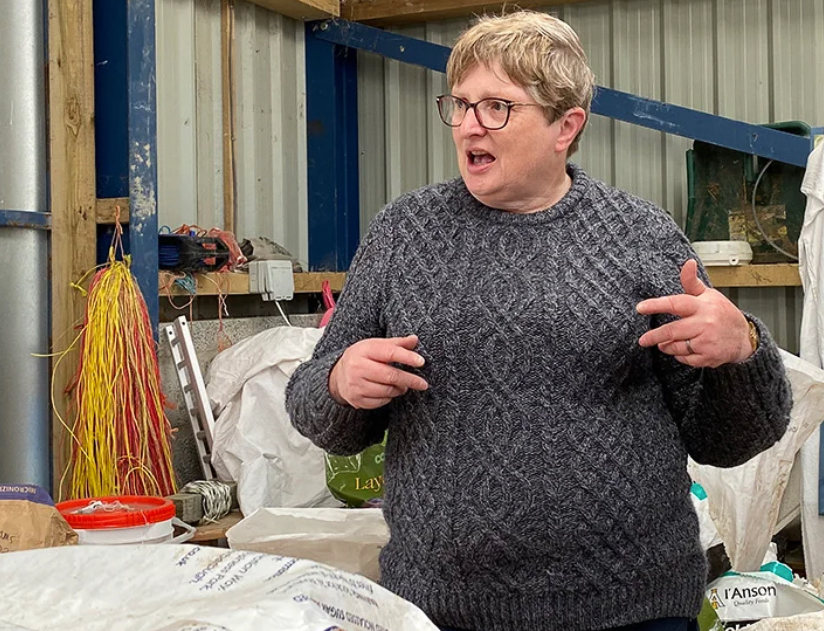D Wood reviews a book that argues for the revival of heritage sheep farming.
As someone dedicated to craft and sustainability, I have recently become aware of an issue that is considered in some craft media but absent from others. For example, conscientious woodworkers procure their raw material from responsibly managed forests, or trees that have come down through acts of nature. Textile artists may use recycled fabric or new yardage sourced as end-of-lines. Jewellers, likewise, re-use gold and silver or obtain it from ethically-mined locations.
But what about glass? The procurement of the mined materials for glass, including studio glass, has not been previously explored, according to an American academic currently undertaking the research. When the book with its findings is published, I look forward to advising Garland readers about it.
In the meantime, The Lost Flock considers a similar topic. Where does your wool, for knitting, spinning and weaving come from? Australia and New Zealand have millions of sheep that offer resources for craftspeople but are they sustainably farmed and their ‘products’ retrieved? Jane Cooper offers some answers.
In 2011, Jane was a doctor’s wife living in Newcastle-on-Tyne, England, with grown children. She spent her days volunteering, gardening and engaging in wool-related crafts. In that year she went to the Orkney Islands in Scotland “to learn more about spinning and lace knitting.” Jane writes well and describes the essence of Orkney: “Atlantic waves, turquoise in the sun, ferociously crashing on white-gold beaches that were empty but for seals and the semi-feral North Ronaldsay sheep. These unique sheep, from the same ancestral roots as Boreray sheep, live on the shores of the island, eating seaweed instead of grass” (40). Needless to say, the environment determined the future: “I recall turning to Paul [her husband] and telling him that I felt I’d ‘come home’.” By mid-2013 Paul had a job as an anaesthetist in the small local hospital and they’d bought a nineteenth-century croft house with acreage near Finstown. This would allow Jane to farm Boreray sheep.
Why Boreray sheep? They are one of the oldest and rarest breeds of sheep in the UK and Jane’s research shows that a feral flock was settled on Boreray Island before the end of the seventeenth century. She first encountered this breed in Wales and admired the wool as well as the “feisty” (20) nature of the rams. The breed is smaller than commercially-raised sheep and varies in colour from cream, through grey and brown to nearly black. The fleece ranges from long coarse fibres to very fine and soft. “This one breed of sheep could supply everything you would need, from the finest wool underwear to the most robust wool jacket, and tough netting and string made from the thicker hairs” (17).
The narrative includes the ancient uses of sheep in Scotland – wool, cheese, meat, dung, skin – as well as interesting facts about wool. For example, a modern replication of a wool sail in Norway shows that Viking ships were equipped with wool sails, which makes sense: the wool’s lanolin made them water-resistant. Now that Jane offers tours of her farm and workshops on spinning, she finds that her visitors are excited by news of Viking women’s weaving of sails.
During the years of Jane’s love affair with Boreray sheep, she set a goal of making them pay as well. She got involved in selling the meat to the local abattoir, along with the slow food movement. She sold fleece and sought ways for skins and horns (both male and female Borerays have horns) to be marketed. The farming was ethical and done with care. Each sheep has a name and Jane deals with their idiosyncrasies: “Gloria turned out to be the supermodel of Borerays with an attitude to match. By chance, I captured a photo of her … after she’d presented us with a lovely pair of twin lambs, that fully conveys her beauty and personality. Her colouring is classic creamy white with a clear inverted ‘V’ revealed in black facial colouring. She has an elegant rather than ‘homely’ profile and seems slightly aloof” (90). A personal relationship with each sheep ensures that when it comes time for slaughtering, it is done in the most humane way possible.
In addition to the tale of a craftswoman being fully involved in the production of her craft and exemplifying sustainable practice, two things stand out for me. Having been on sheep farms in New Zealand, I made the assumption that what I saw was state-of-the-art practice. Now I recognise that it was status quo practice. The Lost Flock makes clear that accepted methods of breeding created the modern, ‘efficient’, large white sheep that dominate fields and hills in the UK and Aotearoa. During the thousands of years of domestication, sheep were bred to reduce the size of horns (rams can kill each other with their horns) and increase the proportion of useable wool. Primitive sheep have shorter tails, excluding the need for docking (cutting domesticated lambs’ long tails); they shed their fleece instead of needing to be sheared regularly; they’re resistant to and have resilience from some diseases; ewes undertake lambing unassisted; and they graze in a range of pasture types, eliminating the top-dressing of thousands of acres of grassland. I’m not expecting Kiwi and Oz sheep farmers to change their ways, but craftspeople should be aware of their sources.
The second significant aspect of Jane’s writing is her advocacy of local economies and agriculture which pays attention to the well-being of societies and the planet. Of her community of farmers, she describes them as:
…some of the most experienced and knowledgeable people in the country in regenerative agriculture and horticulture. People with the very skills that would be desperately needed for the provision of nutritious healthy food by and for communities, respecting their local customs and traditions, acknowledging the community role of good food beyond mere nutrition, reversing biodiversity loss and contributing positively to measures addressing the climate change and pollution challenges facing the world (155).
This book would be of special interest to those wanting immersion in the details of farming heritage animals. Yet, as Garland goes forward with its Value of Craft report, similar values of sustainment are contained in The Lost Flock. I might go so far as to say that while I was drawn to the book because of its wool crafts, I am left with a lasting impression of the craft of farming with care.

Jane Cooper The Lost Flock: Rare wool, wild isles & one woman’s journey to save Scotland’s original sheep, Chelsea Green Publishing, 2023
Visit www.orkneyboreray.com



